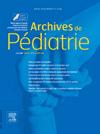Hutchinson-Gilford早衰综合征患者颅内高压1例。
IF 1.3
4区 医学
Q3 PEDIATRICS
引用次数: 0
摘要
哈钦森-吉尔福德综合征,也被称为早衰症,是一种罕见的遗传性疾病,从新生儿时期就会导致过早和加速衰老。这种疾病是由LMNA基因的新生突变引起的。患者表现出一系列症状,包括皮肤、骨骼、关节和心脏疾病,以及特征性面部畸形。颅内高压不是本病的已知症状。据我们所知,迄今为止,文献中还没有一例哈金森-吉尔福德综合征患者在没有创伤背景的情况下表现为颅内高压。本报告报告了一个被诊断为哈钦森-吉尔福德综合征的儿童,他在三岁时出现颅内高压,没有发现继发原因。需要长期使用乙酰唑胺来控制颅内高压。我们假设颅内高压可能与Hutchinson-Gilford综合征中观察到的血管异常有关,这可能导致静脉引流功能障碍。为了支持颅内高压与Hutchinson-Gilford综合征之间存在非随机关联的假设,需要进一步报道该综合征患儿的类似病例。本文章由计算机程序翻译,如有差异,请以英文原文为准。
Intracranial hypertension in a patient with Hutchinson-Gilford progeria syndrome
Hutchinson-Gilford syndrome, also known as progeria, is a rare genetic disorder that causes premature and accelerated ageing from the neonatal period. The disease is caused by de novo mutations in the LMNA gene. Patients present with a range of symptoms, including skin, bone, joint and cardiac disorders, as well as characteristic facial dysmorphia. Intracranial hypertension is not a known symptom of this disease. To the best of our knowledge, no case of a patient with Hutchinson-Gilford syndrome presenting with intracranial hypertension without a traumatic context has been reported in the literature to date. This report presents the case of a child diagnosed with Hutchinson-Gilford syndrome who presented with intracranial hypertension at the age of three years, with no secondary cause identified. Long-term treatment with acetazolamide was required to control the intracranial hypertension. We hypothesise that the intracranial hypertension may be related to vascular abnormalities observed in Hutchinson-Gilford syndrome, which may cause a venous drainage dysfunction. To support the hypothesis of a non-random association between intracranial hypertension and Hutchinson-Gilford syndrome, further reports of similar cases in children with the syndrome are required.
求助全文
通过发布文献求助,成功后即可免费获取论文全文。
去求助
来源期刊

Archives De Pediatrie
医学-小儿科
CiteScore
2.80
自引率
5.60%
发文量
106
审稿时长
24.1 weeks
期刊介绍:
Archives de Pédiatrie publishes in English original Research papers, Review articles, Short communications, Practice guidelines, Editorials and Letters in all fields relevant to pediatrics.
Eight issues of Archives de Pédiatrie are released annually, as well as supplementary and special editions to complete these regular issues.
All manuscripts submitted to the journal are subjected to peer review by international experts, and must:
Be written in excellent English, clear and easy to understand, precise and concise;
Bring new, interesting, valid information - and improve clinical care or guide future research;
Be solely the work of the author(s) stated;
Not have been previously published elsewhere and not be under consideration by another journal;
Be in accordance with the journal''s Guide for Authors'' instructions: manuscripts that fail to comply with these rules may be returned to the authors without being reviewed.
Under no circumstances does the journal guarantee publication before the editorial board makes its final decision.
Archives de Pédiatrie is the official publication of the French Society of Pediatrics.
 求助内容:
求助内容: 应助结果提醒方式:
应助结果提醒方式:


